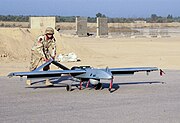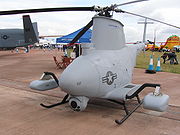UAVs perform a wide variety of functions. The majority of these functions are some form of remote sensing; this is central to the reconnaissance role most UAVs fulfill. Less common UAV functions include interaction and transport.
Remote sensing

A Bell Eagle Eye, used by the US Coast Guard 
The RQ-7 Shadow is capable of delivering a 20-lb. "Quick-MEDS" canister to front-line troops. 
Malazgirt VTOL Mini Unmanned System operated by Turkish Armed Forces UAV remote sensing functions include electromagnetic spectrum sensors, biological sensors, and chemical sensors. A UAV's electromagnetic sensors typically include visual spectrum, infrared, or near infrared cameras as well as radar systems. Other electromagnetic wave detectors such as microwave and ultraviolet spectrum sensors may also be used, but are uncommon. Biological sensors are sensors capable of detecting the airborne presence of various microorganisms and other biological factors. Chemical sensors use laser spectroscopy to analyze the concentrations of each element in the air.
Transport
UAVs can transport goods using various means based on the configuration of the UAV itself. Most payloads are stored in an internal payload bay somewhere in the airframe. For many helicopter configurations, external payloads can be tethered to the bottom of the airframe. With fixed wing UAVs, payloads can also be attached to the airframe, but aerodynamics of the aircraft with the payload must be assessed. For such situations, payloads are often enclosed in aerodynamic pods for transport.
Scientific research
Unmanned aircraft are uniquely capable of penetrating areas which may be too dangerous for piloted craft. The National Oceanic and Atmospheric Administration (NOAA) began utilizing the Aerosonde unmanned aircraft system in 2006 as a hurricane hunter. AAI Corporation subsidiary Aerosonde Pty Ltd. of Victoria (Australia), designs and manufactures the 35-pound system, which can fly into a hurricane and communicate near-real-time data directly to the National Hurricane Center in Florida. Beyond the standard barometric pressure and temperature data typically culled from manned hurricane hunters, the Aerosonde system provides measurements far closer to the water’s surface than previously captured. Further applications for unmanned aircraft can be explored once solutions have been developed for their accommodation within national airspace, an issue currently under discussion by the Federal Aviation Administration.
Precision strikes
See also: Unmanned Combat Aerial Vehicle

Rear view of a MQ-1 Predator(Reno Air Show) MQ-1 Predator UAVs armed with Hellfire missiles are now used as platforms for hitting ground targets in sensitive areas. Armed Predators were first used in late 2001 from bases in Pakistan and Uzbekistan, mostly for targeted assassinations inside Afghanistan. Since then, there were several reported cases of such assassinations taking place in Pakistan, this time from Afghan-based Predators. The advantage of using an unmanned vehicle, rather than a manned aircraft in such cases, is to avoid a diplomatic embarrassment should the aircraft be shot down and the pilots captured, since the bombings took place in countries deemed friendly and without the official permission of those countries.[10][11][12][13]
A Predator, based in a neighboring Arab country, was used to kill suspected al-Qa'ida terrorists in Yemen on November 3, 2002. This marked the first use of an armed Predator as an attack aircraft outside of a theater of war such as Afghanistan.[14]
Search and rescue
UAVs will likely play an increased role in search and rescue in the United States. This was demonstrated by the successful use of UAVs during the 2008 hurricanes that struck Louisiana and Texas.
For example, Predators, operating between 18,000-29,000 feet above sea level, performed search and rescue and damage assessment. Payloads carried were an optical sensor, (which is a daytime and infra red camera), and a synthetic aperture radar. The Predator's SAR is a sophisticated all-weather sensor capable of providing photographic-like images through clouds, rain or fog, and in daytime or nighttime conditions; all in real-time. A concept of coherent change detection in SAR images allows for exceptional search and rescue ability: photos taken before and after the storm hits are compared and a computer highlights areas of damage
Endurance

RQ-4 Global Hawk, a high-altitude reconnaissance UAV capable of 36 hours continuous flight time Because UAVs are not burdened with the physiological limitations of human pilots, they can be designed for maximized on-station times. The maximum flight duration of unmanned, aerial vehicles varies widely. Internal-combustion-engine aircraft endurance depends strongly on the percentage of fuel burned as a fraction of total weight (the Breguet endurance equation), and so is largely independent of aircraft size. Solar-electric UAVs hold potential for unlimited flight, a concept originally championed by the Aerovironment Helios Prototype, which was destroyed in a 2003 crash. One of the major problems with UAVs is no capability for inflight refuelling. Currently the US Air Force is promoting research that should end in an inflight UAV refueling capability, which should be available by 2010.
The Defense Advanced Research Projects Agency (DARPA) is to sign a contract on building an UAV which should have an enormous endurance capability of about 5 years. The project is entitled "Vulture". The developers are certain neither on the design of the UAV nor on what fuel it should run to be able to stay in air without any maintenance for such a long period of time.
Notable high endurance flights| UAV | Flight time | Date | Notes |
|---|
| QinetiQ Zephyr Solar Electric | 82 hours 37 minutes | 28-31 July 2008 | QinetiQ press release |
| Boeing Condor | 58 hours, 11 minutes | ? | The aircraft is currently in the Hiller Aviation Museum, CA. Hiller Aviation Museum reference to the flight |
| QinetiQ Zephyr Solar Electric | 54 hours | September 2007 | QinetiQ press release New Scientist article |
| IAI Heron | 52 hours | ? | NOVA PBS TV program reference IAI reference |
| AC Propulsion Solar Electric | 48 hours, 11 minutes | June 3, 2005 | AC Propulsion release describing the flight |
| MQ-1 Predator | 40 hours, 5 minutes | ? | UAV Forum reference Federation of American Scientists reference |
| GNAT-750 | 40 hours | 1992 | Directory of US Military Rockets and Missiles reference to the flight UAV Endurance Prehistory reference |
| TAM-5 | 38 hours, 52 minutes | August 11, 2003 | Smallest UAV to cross the Atlantic TAM Homepage TAM-5 FAQ page |
| Aerosonde | 38 hours, 48 minutes | May 3, 2006 | Aerosonde release on the flight |
| I-GNAT | 38 hours, landed with 10-hour reserve | ? | General Atomics reference to the flight |
| RQ-4 Global Hawk | 36 hours | ? | Space Daily story on the flight RAND Corporation report |
| Aerosonde "Laima" | 26 hours, 45 minutes | August 21, 1998 | First UAV to cross the Atlantic Aerosonde Laima page Seattle Museum of Flight |
| Vulture(UAV) | Has not flown. Potential endurance 5 years | ? | A DARPA project - Vulture - The Unmanned Aircraft Able to Stay in the Air for 5 Years
|

















